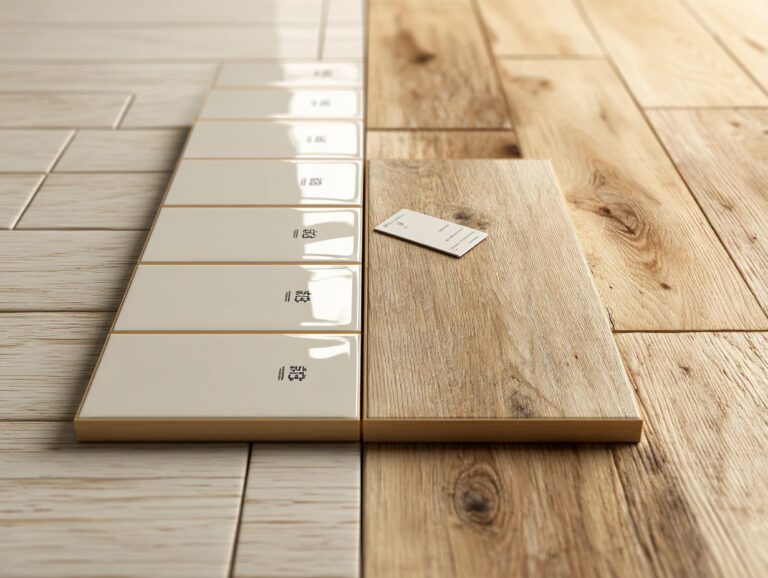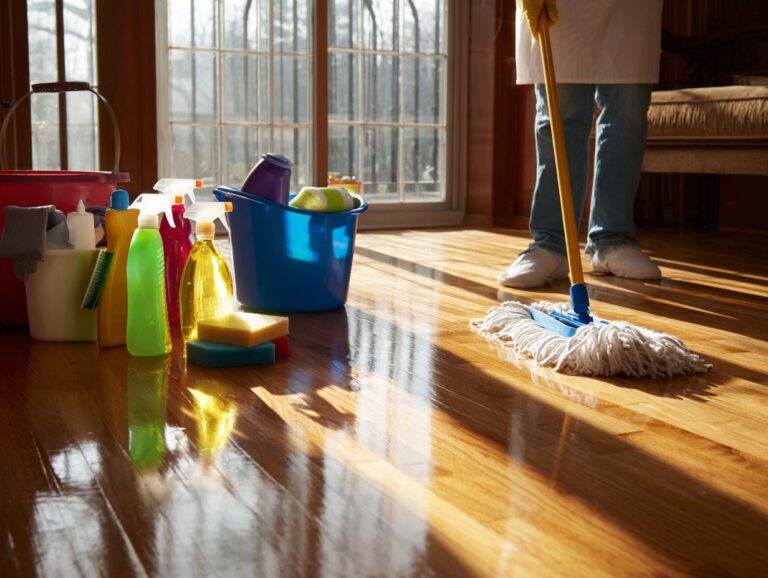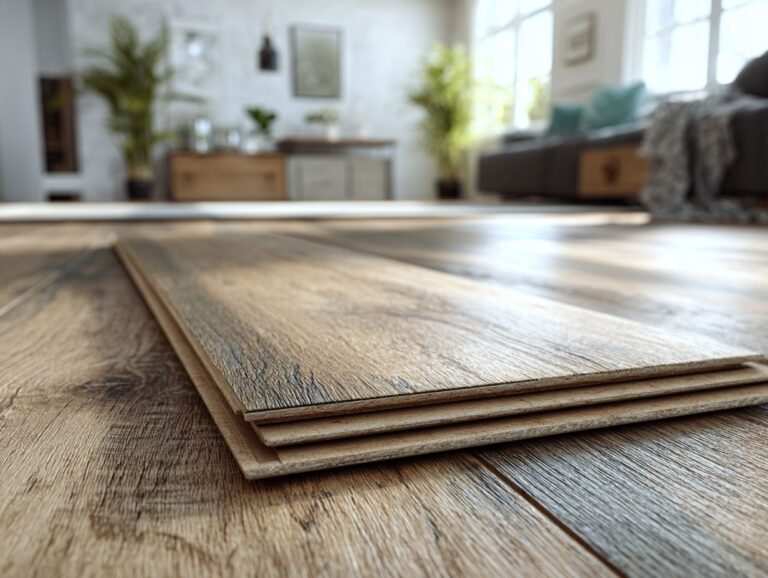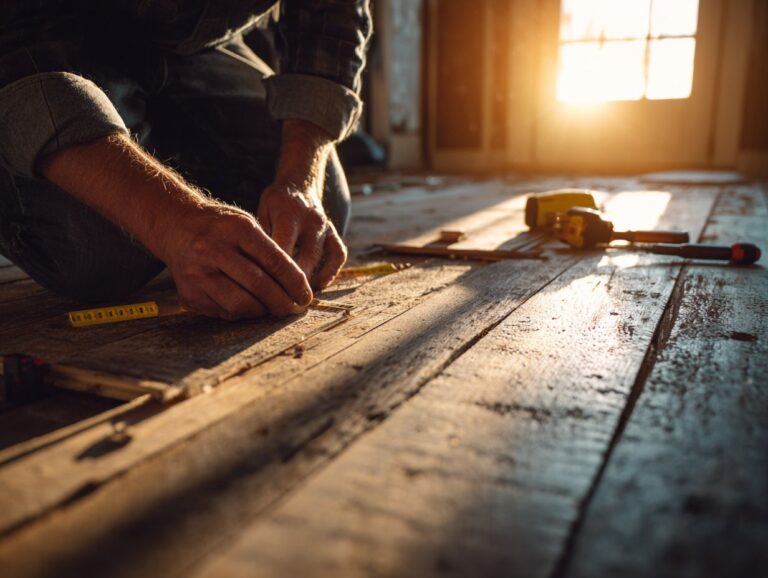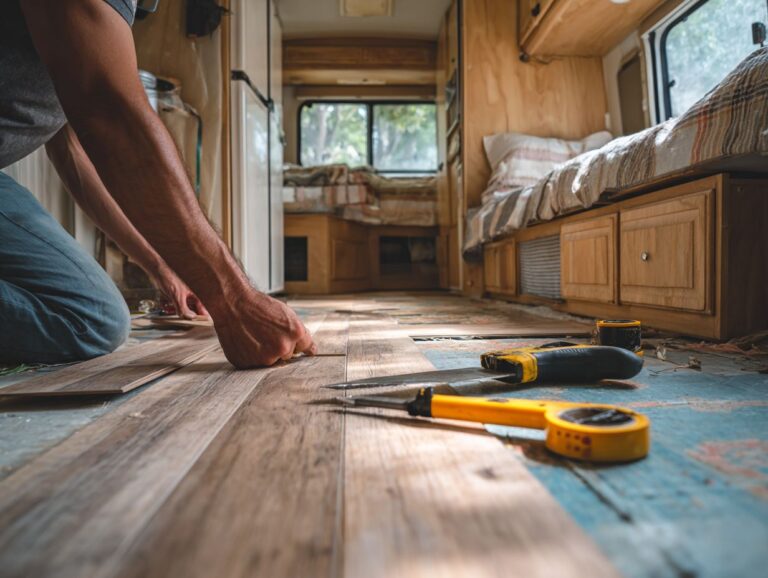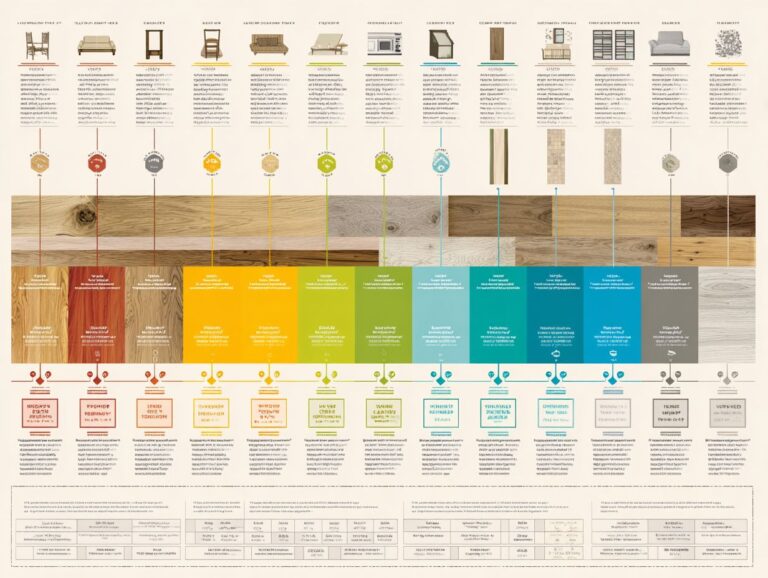Subfloor Repair Costs – Common Issues and Pricing
A damaged subfloor can lead to costly repairs and safety hazards in your home. Common issues like water damage, termite infestations, and rotting plywood can escalate repair costs quickly. Knowing these problems is important for homeowners who want to keep their foundation safe and solid. This article will discuss common expenses for repairing subfloors, kinds of damage you might encounter, and sensible methods to keep your home secure without spending too much.
Key Takeaways:
Contents
Importance of a Healthy Subfloor
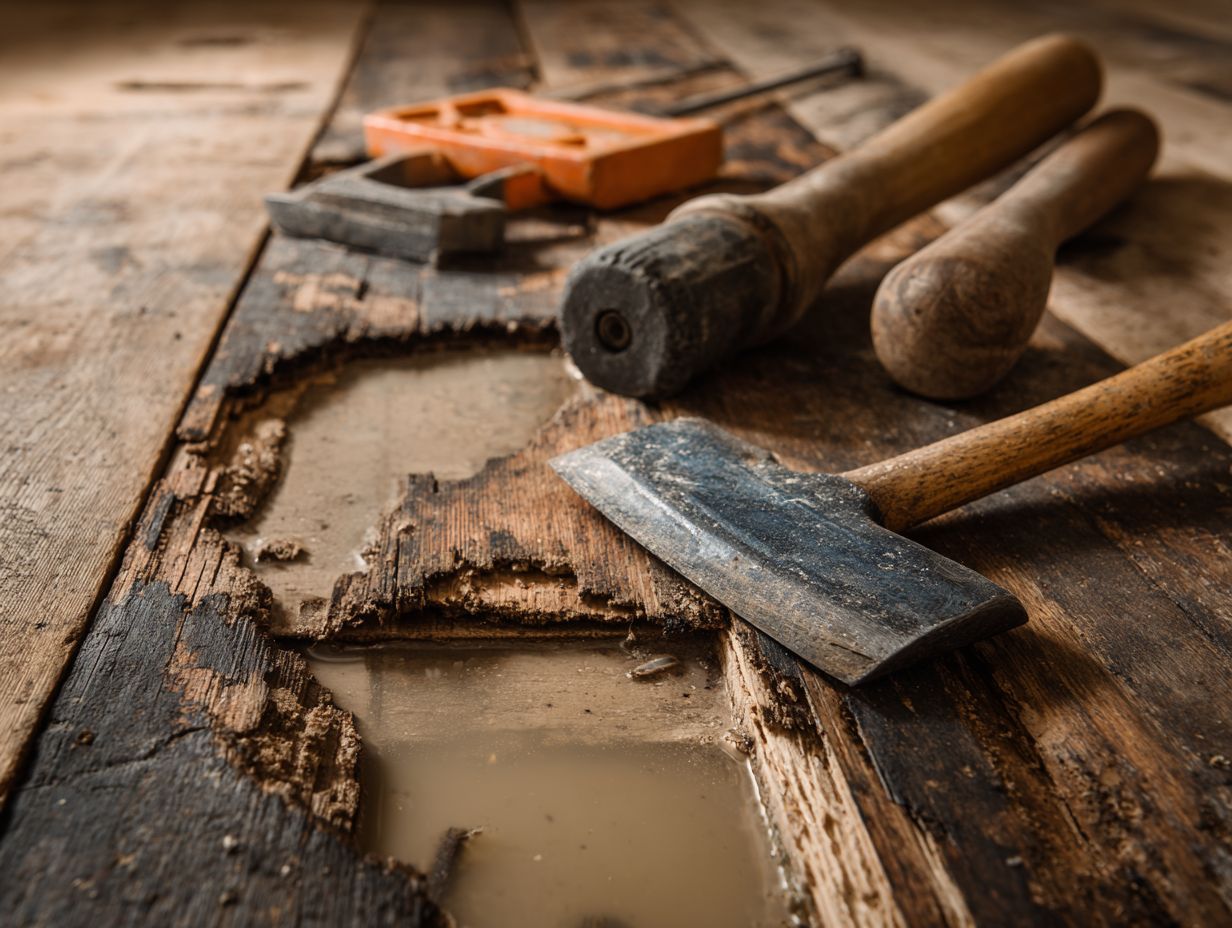
A strong subfloor is important for your flooring and the structure of your home, affecting insulation and moisture control.
Neglecting subfloor issues can lead to significant consequences. For instance, a compromised subfloor might cause heat loss, resulting in increased heating costs.
Moisture entering can cause mold, impacting air quality and resulting in health issues. Wooden floors over damaged subfloors can warp or buckle, necessitating costly repairs.
To prevent these issues, regularly inspect for any damage, such as sagging or squeaking, and consider adding a moisture barrier during installation. Related insight: Basement Flooring Solutions – Moisture and Mold Prevention offers strategies to protect your subfloors effectively.
Focusing on your subfloor will improve your home’s comfort and energy use.
Overview of Common Subfloor Issues
Common problems with subfloors include water damage, pest infestations, and weak structures, which can get worse if not fixed quickly.
Water damage often stems from leaks or high humidity, leading to mold and deterioration. Pest infestations, especially from termites, can compromise wooden structures.
Structural inadequacies may arise due to inadequate support or improper installation, creating uneven surfaces.
To tackle these problems, homeowners should:
- Regularly inspect their subfloors for signs of moisture or pest activity,
- Invest in moisture barriers during installation,
- Make sure crawl spaces have enough airflow.
These proactive measures can significantly extend the lifespan of your flooring and prevent costly repairs. For an extensive analysis of solutions, our comprehensive Subfloor Damage Assessment and Repair Guide offers detailed advice.
Common Subfloor Issues
Spotting typical subfloor problems early is important to fix them quickly, which can save a lot on repairs and stop major harm.
Water Damage
Water damage can be insidious, often presenting as mold growth and structural weakness, affecting both plywood and concrete subfloors alike.
To assess potential water damage, start by checking for dark spots or warped flooring.
Use a moisture meter, such as the Wagner MMC220 ($129), to check moisture levels in both types of subfloors. If readings go above 18%, you should look into it more.
Preventive measures include:
- Installing a sump pump in vulnerable areas
- Applying waterproofing sealants
- Ensuring proper drainage around your home
Regular inspections, especially after heavy rains or snow melt, can help catch issues before they escalate.
Pest Infestation
Issues with pests, such as termites or beetles that damage wood, can badly affect subfloors. Regular inspections and treatments are necessary.
To identify a pest infestation, look for specific signs like mud tubes on walls, discarded wings, or hollow-sounding wood.
Regular check-ups every six months can catch issues early. If you see these signs or think you have a pest problem, it’s important to get in touch with a company like Terminix.
Their initial treatment averages around $250 and includes a thorough inspection, extermination strategies, and preventative measures to safeguard your home.
Being proactive in pest management can save you costly repairs down the line.
Rotting Wood
Rotting wood in subfloors typically results from prolonged moisture exposure, leading to compromised structural integrity and potential safety hazards.
To identify rotting wood, look for discoloration, soft spots, or a musty odor. Common causes include leaky plumbing, inadequate ventilation, or external water sources.
Once you’ve determined the extent of the damage, you can choose between patching or replacing the wood.
- For a DIY patch using plywood, expect to spend around $25 per sheet; cut out the rotted area, fit the new piece, and secure it with screws.
- Sometimes, you may need to completely replace the floorboards, and this can lead to extra expenses for both the work needed and the supplies.
Uneven Flooring
Uneven flooring is often a sign of underlying subfloor issues, which can stem from improper installation or damage over time.
To assess the problem, begin by using a long level or straight edge, measuring across various sections of the floor. Identify areas that deviate significantly from a level plane.
For leveling, consider using self-leveling compound, which costs about $30 for a 50lb bag. Begin by ensuring the subfloor is both clean and dry. Next, prepare the compound as directed by the manufacturer.
Pour it into the low spots and let it spread naturally, creating a smooth surface. This method effectively resolves minor height differences, restoring your floor’s evenness.
Creaking or Squeaking Sounds
Noises like creaks or squeaks in your house usually mean there are loose or broken joists in the subfloor that need immediate repair.
To address these issues, begin by reinforcing loose joists with 3-inch deck screws, which can be found in most hardware stores for about $10 for a box.
Applying a lubricant solution, such as silicone spray, to the affected areas can reduce friction and noise.
If you need to replace any damaged sections, plywood sheets typically cost around $20 for a 4×8 sheet.
Using these methods can make the floor quieter, more stable, and help your flooring last longer.
Assessing Subfloor Damage
Carefully checking subfloor damage is key to choosing the correct repair method, saving time and money later. For a comprehensive understanding, see also: Subfloor Damage Assessment and Repair Guide.
Signs of Damage to Look For

Key signs of subfloor damage include water stains, warped boards, and unpleasant odors, which signal potential issues requiring immediate action.
To identify these signs, start by inspecting your floors for visible water stains, which often appear as dark patches near plumbing fixtures.
Check for warping by walking over the surface; if it feels uneven or bouncy, this may indicate a problem. Unpleasant odors, especially musty smells, can signal trapped moisture or mold.
Use a moisture meter to assess humidity levels in the wood; anything above 14% suggests an issue. Fixing these warnings promptly can prevent further damage and costly repairs.
DIY Inspection Techniques
Homeowners can check for subfloor damage on their own by using basic tools like a flashlight and a moisture meter to find it accurately.
-
Start by using a flashlight to examine the corners and edges of rooms for signs of water staining or mold.
-
Next, invest in a moisture meter, which typically costs around $40, to measure the moisture levels in the subfloor; readings above 16% often indicate potential problems.
-
Checking for squeaky or bouncy floors during normal walking can reveal loose or damaged floorboards needing attention.
-
By regularly checking these areas, homeowners can find problems early and avoid expensive repairs later.
When to Call a Professional
Be aware of when to call an expert; serious damage or problems with the building usually require expert help for safe repairs.
For instance, if you notice extensive water damage-such as mold growth or sagging ceilings-it’s best to contact a water damage restoration specialist. These experts typically charge between $75 and $150 per hour.
Similarly, if you’re dealing with a pest infestation, professional exterminators can provide targeted solutions, often starting around $100.
Figuring out how serious the problem is important; small leaks or minor pest issues might be something you can handle yourself, but bigger problems need quick help from professionals to stop them from getting worse.
Repair Options for Subfloors
Knowing about the different ways to fix subfloors helps homeowners pick the right option for their particular situation. For more detailed guidance, check out our comprehensive Subfloor Damage Assessment and Repair Guide.
Patch Repair
Patch repair is an effective solution for minor damages, requiring materials like plywood or OSB boards to restore the subfloor’s integrity.
- Start by measuring the damaged area to cut the plywood or OSB board to size, usually around a 1-inch overlap from the edges of the damage. Use a jigsaw or circular saw for accurate cuts.
For securing the patch, you’ll need construction adhesive and screws, which typically cost between $25 and $50 total. Allow 2-3 hours for the entire process, including drying time for the adhesive.
Finish the surface with flooring of your choice, ensuring a seamless transition.
Full Replacement
If the subfloor is in very bad condition, it might have to be completely replaced to keep it strong and safe for an extended time.
To replace a subfloor, start by gathering materials: 3/4″ plywood, screws, and a circular saw.
Estimate costs at approximately $1.50 to $3.50 per square foot for plywood, depending on quality.
Begin by removing the damaged section; this typically takes 1-2 hours. Cut the new plywood to the needed size and attach it with screws spaced 8 inches apart.
Allow a full day for this process, including drying time for any adhesives used. Make sure all safety rules are followed, like wearing gloves and masks to avoid dangers.
Reinforcement Techniques
Strengthening methods, like installing additional support or attaching extra joists, can help subfloors with small structural issues.
To install blocking, put small wooden boards between the joists, ideally every 4 feet. Secure these blocks with screws for added stability.
Sistering joists involves attaching a new, full-length beam alongside damaged ones; use at least 2×6 lumber for equivalent strength, fastening it with screws or nails spaced 16 inches apart.
Both methods can be completed with common tools like a drill, circular saw, and level. Material costs are expected to remain around $100 for a stronger and more lasting subfloor.
Cost Factors for Subfloor Repair
Various costs affect subfloor repair, such as the type of materials used, the cost of labor, and the location of the project. To better understand these factors, you might find our detailed Subfloor Damage Assessment and Repair Guide useful.
These factors affect the total project cost.
Material Costs
Material costs for subfloor repairs can vary significantly, with options ranging from $0.75/sq ft for OSB to over $3/sq ft for high-performance panels.
For OSB (Oriented Strand Board), at around $0.75/sq ft, it’s an economical choice ideal for new constructions or as a base layer.
Plywood costs around $1.50 per square foot and holds up better in wet conditions, making it suitable for humid environments.
For higher performance, consider cement boards, which cost about $2.50-$3.00/sq ft, particularly beneficial in bathrooms or kitchens.
Evaluate your project needs to select the best subflooring material that balances cost, durability, and specific environmental conditions.
Labor Costs

Labor costs for subfloor repair are typically between $70 and $120 each hour, based on how difficult the work is and the contractor’s skill level.
Consider different details to get accurate quotes.
First, outline the project scope clearly-include details like the size of the area and the extent of damage.
Second, compare estimates from at least three contractors to gauge an average. Ask about their experience and any warranties on work.
Geographic location also plays a significant role; for example, urban contractors may charge higher rates due to demand.
With this information, you can choose an option that is both affordable and provides quality work.
Geographic Location
Where you live significantly affects subfloor repair costs. People in cities usually pay more because of high demand and living expenses.
For instance, a subfloor repair in New York City might range from $65 to $125 per square foot, influenced by high labor costs and material expenses.
In contrast, rural areas can see costs as low as $30 to $60 per square foot, where labor is generally cheaper. Local permits and regulations can add to expenses; urban environments often have more stringent requirements.
Think about these points when planning for repair costs to get a correct total amount.
Extent of Damage
The level of damage affects how repairs are done and their costs, with small issues needing simple repairs and big problems needing more thorough solutions.
For minor repairs, such as fixing shallow dents or minor paint scratches, costs typically range from $50 to $300. These can often be done using tools like a paintless dent repair kit or localized touch-up paint.
In contrast, extensive damage, such as a bent frame or significant rust, may lead to costs between $1,000 and $3,000 for full replacements. Look for any problems in the building and get a professional to give an accurate cost estimate based on your findings.
Average Pricing for Subfloor Repairs
Knowing the typical costs of subfloor repairs helps homeowners plan their expenses and find ways to save money.
Subfloor Replacement Cost Analysis
Subfloor Replacement Cost Analysis
Average Replacement Costs: Subfloor Replacement Cost per Sq Ft
Labor Cost: Labor Cost per Hour
Additional Costs: Permit Cost
Repair Costs: Small Area Subfloor Repair Cost
The Subfloor Replacement Cost Analysis gives a complete overview of the financial details involved in replacing subflooring materials, such as costs for materials, labor charges, permits, and repairs. Knowing these costs is important for planning and making decisions in building or renovation projects.
Average Replacement Costs reveal the expenses associated with different subfloor materials.
- Plywood is the most economical option, costing approximately $2.2 per square foot This makes it a favored option for projects with limited budgets. Despite its cost-effectiveness, it may not offer the same durability as other materials.
- OSB (Oriented Strand Board) is slightly more expensive at $2.5 per square foot. It offers a balance between cost and performance, providing strength and stability for many applications.
- Amdry/Barricade is notably more expensive at $10 per square foot. These materials are designed for superior moisture resistance and insulation, justifying their higher price point for specific needs like basements or areas with high humidity.
Labor Costs range from $25 to $45 per hour, depending on the complexity and location of the project. Qualified workers are needed for correct installation, which can greatly influence both the price and the result.
Additional Costs include permit fees, which vary from $50 to $200. Getting the required permits is an important step to follow local building rules and avoid possible legal problems.
When dealing with Repair Costs for small areas, expenses can range between $100 and $300. These repairs may involve fixing localized damage like water infiltration or structural weaknesses, which, if left unaddressed, could lead to more significant problems.
This analysis provides a detailed view of the financial considerations involved in subfloor replacement. By being aware of the costs related to materials, labor, permits, and repairs, homeowners and contractors can make decisions that fit their budget and project needs, leading to smooth and successful subfloor installations.
Cost Breakdown by Issue

The costs associated with subfloor repairs can vary significantly based on the issue at hand, ranging from $500 for minor water damage to $2,500 for full replacements.
Common subfloor issues include:
- Minor Water Damage: Average repair costs about $500. Use epoxy or specialized sealants to address these spots.
- Moderate Water Damage: Ranges from $1,000 to $1,500. This might involve replacing sections of plywood, typically managed by a contractor.
- Full Replacement: Typically costs $1,500 to $2,500, requiring complete removal and installation of new subflooring. In this situation, think about using materials that resist moisture to avoid problems later on.
Fixing these problems quickly can stop larger expenses and keep the structure safe.
Estimates for DIY vs. Professional Repairs
DIY repairs can save homeowners significant costs, with average estimates ranging from $300 to $800, compared to hiring professionals, which can run $1,500 to $3,000.
To effectively tackle DIY repairs, consider starting with simpler tasks like patching drywall or fixing leaky faucets.
Tools like a basic toolbox ($30), a drill ($50), and a stud finder ($20) can equip you for various projects.
While DIY saves money, you should weigh potential downsides, such as time investment and the risk of mistakes. For instance, if you attempt electrical repairs without experience, it could lead to costly damages or safety hazards.
Therefore, assess each task’s complexity before deciding whether to do it yourself or call in a professional.
Frequently Asked Questions
What are common subfloor repair issues?
Some common subfloor repair issues include water damage, termite damage, rotting wood, and uneven flooring caused by structural issues.
How much does subfloor repair typically cost?
The cost of subfloor repair can vary greatly depending on the extent of the damage and the materials needed, but it typically ranges from $500 to $5,000.
Do I need to hire a professional for subfloor repair?
If the damage is minor, it is possible to repair the subfloor yourself. For larger or structural damage, hiring a professional is suggested for proper and safe repairs.
What factors can affect the cost of subfloor repair?
The price for fixing a subfloor depends on how big the damaged part is, what kind of subfloor material it is, how bad the damage is, and how much workers charge in your region.
Can I prevent the need for subfloor repair?
Although some damage to the subfloor can’t be avoided, you can prevent repairs by routinely checking for water leaks and quickly dealing with any termite problems.
Does homeowners insurance cover subfloor repair costs?
In some cases, homeowners insurance may cover the cost of subfloor repair if the damage was caused by a covered peril, such as a burst pipe. It is best to check with your insurance provider to see if your policy covers subfloor repairs.
